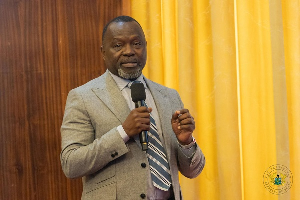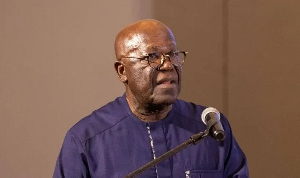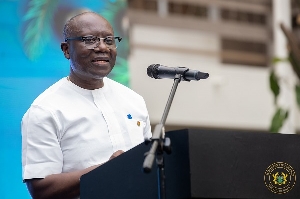Ghana is emerging as a competitive destination for business despite recent economic challenges
facing the West Africa Country. The government of Ghana has successfully created the
momentum that has the potential to spur growth and bring the country back on the path of
impressive growth and prosperity.
Maintaining this momentum depends on the country fostering inclusive growth. One lever for
change is the opportunity presented by education and literacy. Education can enable high
potential but disadvantaged people to participate effectively in the national and global economy.
Education of the Girl Child presents a dynamic opportunity for female youth to build sustainable
careers and livelihoods
However, one of the major barriers to female access to education has been found to be
inextricably related to menarche and its attendant challenges. In fact, a good number of female
school children fail to report to school when they are in their menses and hence poor
performance and increased likelihood of drop out. The incidence of drop out of the girl child
from school is also related to the incidence of early marriage and its known consequences.
It is in recognition of the importance of the removal of all barriers to education of the girl and the
combat against early marriage that the Dutch Government in partnership with the Government of
Ghana with support from United Nations Children Fund (UNICEF) is currently implementing a
program that is focusing on behavioral change with the aim of increasing educational
opportunities for girls who are currently out of school. Apart from cultural and social norms
which enhance the likelihood of the girl child staying out of school, it has been shown that
difficulties associated with menstruation present a major barrier to access and any intervention
that is intended to eliminate this barrier deserves the support of informed and well-meaning
Ghanaians.
The Evidence
Research Article, ‘Sanitary Pad Interventions for Girls' Education in Ghana: A Pilot Study by
Paul Montgomery, Caitlin R. Ryus, Catherine S.Dolan, Sue Dopson,Linda M. Scott
Abstract
Background; Increased education of girls in developing contexts is associated with a number of
important positive health, social, and economic outcomes for a community. The event of
menarche tends to coincide with girls' transitions from primary to secondary education and may
constitute a barrier for continued school attendance and performance. Following the MRC
Framework for Complex Interventions, a pilot controlled study was conducted in Ghana to assess
the role of sanitary pads in girls' education. Methods; A sample of 120 schoolgirls between the ages of 12 and 18 from four villages in
Ghana participated in a non-randomized trial of sanitary pad provision with education. The trial
had three levels of treatment: provision of pads with puberty education; puberty education alone;
or control (no pads or education). The primary outcome was school attendance.
Results; After 3 months, providing pads with education significantly improved attendance among
participants, (lambda 0.824, F = 3.760, p<.001). After 5 months, puberty education alone
improved attendance to a similar level (M = 91.26,SD= 7.82) as sites where pads were provided
with puberty education (Rural M = 89.74,SD= 9.34;
Per urban M = 90.54,SD= 17.37), all of which were higher than control(M = 84.48,SD= 12.39).
The total improvement through pads with education intervention after 5 months was a 9%
increase in attendance. After 3 months, providing pads with education significantly improved
attendance among participants. The changes in attendance at the end of the trial, after 5 months,
were found to be significant by site over time. With puberty education alone resulting in a
similar attendance level.
Conclusion; This pilot study demonstrated promising results of a low-cost, rapid-return
intervention for girls' education in a developing context. Given the considerable development
needs of poorer countries and the potential of young women there, these results suggest that a
large-scale cluster randomized trial is warranted. Trial Registration
This is an open-access article distributed under the terms of the Creative Commons Attribution
License, which permits unrestricted use, distribution, and reproduction in any medium, provided
the original author and source are credited.
Funding: The study was funded by Templeton College, the John Fell Fund and Green Templeton
College - all at Oxford University. Pads were supplied by Proctor and Gamble. No supporter of
the study had any influence over the publication of any results. The funders had no role in study
design, data collection and analysis, decision to publish, or preparation of the manuscript.
Competing interests: The authors have read the journal's policy and have the following conflicts:
pads were supplied by Proctor and Gamble. This does not alter the authors' adherence to all the
PLOS ONE policies on sharing data and materials.
Narok, Kenya: An initiative that seeks to provide all secondary school girls in Narok County
with a year’s supply of sanitary pads has been put in place by Narok Deputy Governor Evelyn
Aruasa.
Aruasa says all 10,556 girls in the 94 secondary schools in the county will get sanitary towels at
a cost of Sh9.6 million shillings.
Speaking to The Standard in her office, Aruasa said the move has been informed by the need to
boost girl education, which she says is still low in the county.
“Many school going girls keep missing school during their menses. Because of poverty, most use
pieces of dirty rags, cotton wool, leaves and paper. Some even wash and recycle. These practices
expose them to diseases and discomfort,” she said.
She expressed optimism that the initiative will raise the girls’ academic performance, restore
dignity and self-esteem.
The deputy governor said this will guarantee access to safe affordable, convenient and culturally
appropriate methods of dealing with menstruation.
PARTNERS APPEAL
“Reports from the Ministry of Education indicate that several girls have dropped out of school
because of the stigma associated with the inability to have sanitary pads. This, in the long run,
restricts the girl from accessing education,” she said, adding that in Narok over 70 per cent of the
girls dropped out because of lack of pads.
She appealed to partners to come on board so that the programme can be extended to benefit
girls in primary schools.
She warned that Kenya’s endeavor for gender parity by 2015 or the Millennium Development
Goals (MDGs) will remain unattainable if the girl child is not retained in school.
“Narok is mainly a patriarchal society and thus, as a county, there is need to do something that
will see girls compete favorably with boys. The first step in empowering women is by making
sure they are in a position to compete with her male counterparts in school,” she said, adding that
Narok becomes the first county to launch such an initiative.
SET ASIDE
In the 2012/2013 financial year the Government set aside Sh300 million for the provision of free
sanitary towels to 568,925 needy girls between Classes six and eight. The amount was, however,
slashed to Sh99 million the following year.
According to the United Nations Children’s Fund 2007 report, a girl in primary school between
grades 6 and 8 (three years) loses approximately 18 weeks out of 108 school weeks. A girl in
high school (four years) loses 156 learning days which is equivalent to almost 24 weeks out of
the 144 weeks of school.
Several other studies across Africa have confirmed the relevance and indeed need for free
sanitary pad as an intervention. Indeed the practice is enjoying massive support in Kenya,
Botswana, Rwanda, Uganda, and the likes.
The Intervention
NTERNATIONAL DEVELOPMENT ASSOCIATION PROJECT APPRAISAL DOCUMENT
ON A CREDIT IN THE AMOUNT OF SDR1O1 MILLION (US$156 MILLION
EQUIVALENT) TO THE REPUBLIC OF GHANA FOR A SECONDARY EDUCATION
IMPROVEMENT PROJECT April 24, 2014
PROJECT DESCRIPTION
A. Project Components
20. The proposed Project would support the Government's Community Day Senior High School
program through two components: (i) Support to Increase Access with Equity and Quality in
Senior High Schools; and (ii) Management, Research and Monitoring and Evaluation.
Component 1: Support to Increase Access with Equity and Quality in Senior High Schools (Total
costs including contingencies: US$140.1 million)
21. Component 1 uses a results-based financing (RBF) modality. Disbursements up to a capped
absolute amount will be made against specific line items in the Education sector annual budget,
referred to as eligible expenditure programs (EEPs). These disbursements will be conditioned on
achievement of specified results, as measured by disbursement-linked indicators (DLIs). A
matrix of indicators has been developed to measure performance annually and monitor the
results achieved (Annex 1).
22. Policies and interventions to be supported are grouped into two pillars: (i) increasing access
with equity (geographic, gender, poverty, etc.); and (ii) improving quality of selected low
performing SHS.
23. Pillar 1: Increase Access with Equity (Total costs including contingencies: US$125.1
million): The objective of this pillar is to improve access to senior secondary education and
improve equity in underserved districts and provide scholarship to students from low income
families, especially girls.
24. The SEIP is expected to finance results of the Government's priority program to expand
space through the construction of new senior secondary schools in underserved areas,
rehabilitation and expansion of existing low performing schools and through support for SHS
attainment of disadvantaged students. The Government plans include new construction in the 14
districts where there are no current operating public SHS. In addition, using the agreed selection
criteria for eligible student population compared with available school capacity (effective
demand) combined with district level poverty indicators, an additional 9 districts have been
identified for new construction. The ultimate objective is to create new spaces for those
demanding seats in SHS and to fill these spaces with new students coming from previously
underserved communities. In addition to new schools, this pillar would focus on improving
existing SHS, particularly those with capacity for expansion, demand for SHS places, poor
learning outcomes, drawing on a needs assessment which will determine level of deficiency
(bathrooms, science labs, computer facilities, etc.) and scope for upgrading. Approximately 125
existing schools would be supported. This pillar will improve the Government's targeting of
resources to support increased access by further supporting scholarships to students from low
income families, especially girls.
25. Given the operation's focus on under-served areas and promoting access with equity,
disbursement will be linked to indicators (DLIs) that measure increases in seat availability in
targeted locations for new construction and increased utilization in existing low-performing
schools where new seats are made available. Targeting resources for students from low income
families, especially girls in underserved communities would further strengthen equity reforms.
Therefore, the release of International Development Association (IDA) credit funds will be
linked to achievement of the following DLIs: (i) selection based on targeting of school expansion
in underserved districts (DLIl); (ii) increase in new seats utilized for SHS students in
underserved districts (DLI 2); (iii) increase in utilized seats in existing selected low-performing
schools (DLI3); and (iv) increased enrolment in selected SHS for students from low-income
families, especially girls (DLI4).
26. Pillar 2: Improve the quality of education in selected low-performing Senior High Schools
(Total costs including contingencies: US$15 million): The objective of this pillar is to improve
the quality of SHS, with a focus on mathematics and science education in selected low
performing schools". The SEIP would also strengthen school management, leadership and
expansion of ICT in the 125 selected low-performing schools. In order to improve quality, the
Project will support the Government's program to: (i) strengthen school management, leadership
and accountability; (ii) target interventions to improve the quality of science and mathematics
education; and (iii) introduce School Performance Partnerships (SPPs) based on School
Performance Partnership Plans (SPPPs) to capture quality improvements. The SPPs would
develop mutual accountability between school management and the District Education Oversight
Committee (DEOC) to improve learning performance with the commitment from government
agencies to provide the necessary resources and the responsibility of schools to implement
quality improvement activities with verifiable outcomes. In addition to school-based quality
inputs, training and financing, this pillar will support the systematic collection and publication of
school data for stakeholders to make informed decisions about SHS selection, and for MOE/GES
to make informed decisions about planning and financing SHS.
27. The focus on mathematics and science subjects is aligned with the Government strategy to
encourage these program areas throughout all education levels. The expansion of ICT wireless
connectivity would also allow strengthened science, mathematics and other subject education
through digital content for teachers and students. Schools will have access to an education
portal1 2(i-campus) where teachers and students can utilize multiple online resources that are
expected to support improved teaching and learning. ICT will be used for intensive in-service
support to teachers to improve content knowledge as well as lesson plan preparation, teaching
and learning aids, and videos on good teaching practices and classroom management. The portal
could also serve as a platform for knowledge exchange with national and international networks
and for participation in relevant discussion forums. The SEIP is expected to provide connectivity
to 125SHS.
28. As an intermediate result, completion rates in the targeted schools would be expected to
increase. A longer term impact would be an increase in student achievement in learning
outcomes (as measured by performance in the WASSCE) which is also a year 4 DLR. For this
pillar, release of IDA credit funds would be linked to the achievement of the following DLIs: (i)
annual publication of School Performance Report (DLI 5); (ii) School Performance Partnerships
(SPPs) in 125 beneficiary schools (DLI 6); and (iii) improved learning outcomes in targeted
selected schools (DLI 7).
29. Component 2: Management, Research and Monitoring and Evaluation (Total costs including
contingencies: US$15.9 million): This component aims to strengthen the implementation
capacity of the MOE and GES and its related implementing agencies and assist them to achieve
the objectives of the Government's SHS strategy. This component will support monitoring and
evaluation (M&E), coordination, planning, communication, financial management, procurement,
and safeguards. In addition it will support an active and evolving research agenda to continue to
inform government SHS policy, particularly with regard to financing, social targeting, quality
initiatives, teacher rationalization, and curriculum relevance. This component would complement
implementation of the program pillars with ongoing analyses, strengthening data collection for
school mapping, and establish priorities for new construction, renovations and maintenance.
The establishment of a web platform for school reporting and real time monitoring of all SHS
implementation activities would enhance and strengthen the Education Management Information
System (EMIS) and school mapping in order to help government report on achievement of
results. In addition, funding will be provided to support the independent verification of
disbursement linked indicators and results. Support would also be provided to help the MOE to
design and realize policy reforms, including piloting and evaluating innovative approaches. This
component would finance training, recruitment of short and long-term technical experts,
procurement of goods needed for specific activities, and incremental operating cost.
The pads distribution falls under the component of equity in access and a scholarship package to
high potential but deprived students to enable access secondary education with less difficulties.
Conclusion
From the above lyrics, one can conclude that the minority and sections of the media have
demonstrated stuck ignorance on the relevance of this excellent intervention. It reflects the extent
to which minority legislators are detached from community development issues since all
committed and well-meaning partners in development are unanimous on the relevance of such an
intervention and would gladly support any initiative that would remove barriers to access to
education for the girl child.
Distribution of sanitary pads in a targeted intervention of this nature can be harnessed to address
the issue of low attendance and increased dropout rate amongst females and to contribute to
positive social outcomes for the girls and their communities. The initiative is well thought out
one and holds the potential to address the serious problem of gender inequity in the development
agenda of this country .It has the unique capacity to provide increased chances of employment to
girls who face barriers to employment and end up as head porters or kayayes as the case may be.
The reaction of the minority is out of ignorance. A good number of girls in Ghana do not attend
school when menstruating.
It is highly recommended that the government scales up this program to support more deprived
girls and also endeavor to provide changing facilities such as separate male and female facilities
at schools since lack of changing facilities also hinders menstruating girls from going to school.
By Dr. Mawia Zakaria.
Executive Director
Institute of Social Research and Development (ISRAD)
Accra. 0244601990.
Opinions of Sunday, 6 July 2014
Columnist: Zakaria, Mawia














